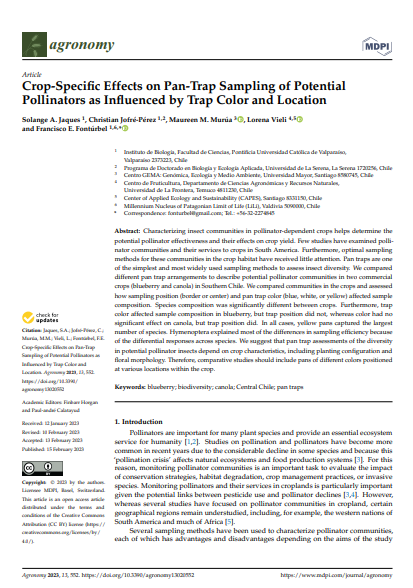Crop-Specific Effects on Pan-Trap Sampling of Potential Pollinators as Influenced by Trap Color and Location

Fecha
2023-03-20Autor
Jaques, Solange A.
Jofré-Pérez, Christian
Murúa, Maureen M. [Univ Mayor, Ctr GEMA Genom Ecol & Medio Ambiente, Chile]
Vieli, Lorena
Fontúrbel, Francisco E.
Ubicación geográfica
Notas
HERRAMIENTAS
Acceda a títulos restringidos
¿Cómo descargar?Resumen
Characterizing insect communities in pollinator-dependent crops helps determine the potential pollinator effectiveness and their effects on crop yield. Few studies have examined pollinator communities and their services to crops in South America. Furthermore, optimal sampling methods for these communities in the crop habitat have received little attention. Pan traps are one of the simplest and most widely used sampling methods to assess insect diversity. We compared different pan trap arrangements to describe potential pollinator communities in two commercial crops (blueberry and canola) in Southern Chile. We compared communities in the crops and assessed how sampling position (border or center) and pan trap color (blue, white, or yellow) affected sample composition. Species composition was significantly different between crops. Furthermore, trap color affected sample composition in blueberry, but trap position did not, whereas color had no significant effect on canola, but trap position did. In all cases, yellow pans captured the largest number of species. Hymenoptera explained most of the differences in sampling efficiency because of the differential responses across species. We suggest that pan trap assessments of the diversity in potential pollinator insects depend on crop characteristics, including planting configuration and floral morphology. Therefore, comparative studies should include pans of different colors positioned at various locations within the crop.
URI
https://repositorio.umayor.cl/xmlui/handle/sibum/9516https://www.mdpi.com/2073-4395/13/2/552/pdf?version=1676516747
https://doi.org/10.3390/agronomy13020552
Coleccion/es a la/s que pertenece:
Si usted es autor(a) de este documento y NO desea que su publicación tenga acceso público en este repositorio, por favor complete el formulario aquí.